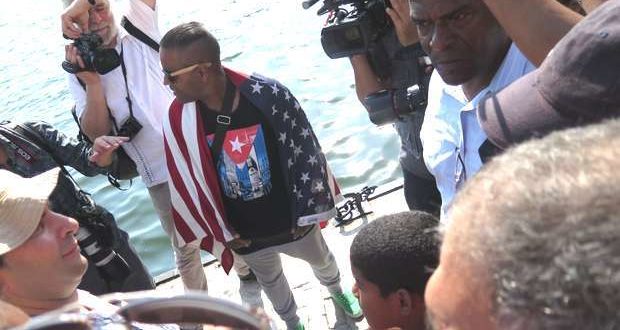
Ivan Garcia, 11 May 2016 — Daniel Llorente Miranda, 52, is a spontaneous dissident. He doesn’t belong to any opposition party, nor is he an un-gagged journalist. He is on his own.
Last 22 March, with the stars and stripes on his shoulders, Llorente found himself in the area of the United State Embassy, waiting to greet President Barack Obama, after he met with a group of opponents, activists and alternative journalists.
Mixed race, a little overweight and short, Daniel defends authentic democracy, believes in freedom of expression and is openly anti-Castro. He shares his narrative peacefully.
On Monday, 2 May, among the many people gathered at the Avenida del Puerto to greet the Adonia cruise ship, again flying the stars and stripes, Daniel Llorente was interviewed by the foreign corespondents when, apparently spontaneously, a thin man with a gray cap, interfered in his exchange with the press, first contradicting him, second act, triggers a blast of support for the regime and he ends up insulting it.
Nearby, five or six brawny guys looking like military in plainclothes join the dispute with the typical verbal verbal lynching: Mercenary! Traitor! Turncoat! ’breaking’ Llorente’s interview with the foreign press.
Then, an undercover agent summoned a police car and the spontaneous dissident was arrested. Before they put him in the car he got a few slaps.
You don’t have to be very insightful to understand that everything was staged. When the altercation got hot, the act of repudiation was joined by people who, supposedly, are not used to different opinions because of their doctrinaire education.
The line of plainclothes agents was in the immediate vicinity of where the independent and foreign press were working. When hearing critical opinions of the government by those being interviewed, we hear shouts of Viva Cuba. But nothing is by chance.
According to a resident of San Isidro, a neighborhood a stone’s throw from the cruise ship terminal., “The lady that was asked to throw water on the guy (Daniel Llorente) sells clothes in the black market. She was formally warned by the police several times and they tried to make her work with them to denounce those selling drugs and prostituting in the area. The black guy with the tattoo is also shameless and corrupt, he was in the war in Angola and belongs the soldier’s association, like the old many who started the discussion, a hard-line member of the CDR (Committee for the Defense of the Revolution).”
It’s not new that the marginals and delinquents collaborate with State Security. Nor are acts of repudiation something new. Many analysts believe they started in 1980 with the emigration of twenty-five thousand Cubans through the Mariel Boatlift.
But the date goes back further. As far back as the spring of 1959, when Fidel Castro supporters, with permission from the authorities, burned newspapers and magazines that reproached the government.
These mobs arrived to injure the journalists critical of Castro. And they were part of the stating of the “people outraged by the unpatriotic role of the press.”
They mobilized sectors of the people to confront those who disagreed and to support Castro’s measures. They did the same to homosexuals, lovers of rock music, and the owners of french fry stands.
The year 1980 marked a turning point in the acts of repudiation. And those who were not outcasts nor bourgeoisie. Nor “mercenaries” nor “counterrevolutionaries.” They were par of this silent mass who apparently applauded a cause, but at the first opportunity fled their homeland.
These verbal lynchings came to be very violent. Dozens were reported injured by beatings and stones thrown by enraged people.
Currently, this reprehensible method is used principally against the dissidence. The site of the Ladies in White in Lawton, or Antonio Rodiles’ house in Miramar, have been surrounded by children and school kids from nearby schools who attend without even knowing the background of the event. They staged a wild party with music to disrupt the activities planned by the opposition.
On 20 March, just when Barack Obama’s Air Force One took off for Havana from Andrews Military Base in the United States, the cowboys of the political police formed their human shield with about three hundred people, to repudiate the Ladies and White and dissident activists.
This has occurred every Sunday for more than a year. After the opponents leave Santa Rita church, the insults, beatings and arrests start. The police authorities can arrest the dissidents alleging any reason, without having to resort to violence or the show.
But it makes up a part of the decalog of the autocracy” counterposing the political differences with a swarm always superior in numbers, of revolutionaries ’disgusted’ with those who oppose the Castro.
The public money, with no consultation with the ordinary people, is spent preparing the act of repudiation. Urban buses are diverted and commerce in the area is paralyzed. Hundreds of students are workers from the area are mobilized, mixed with the paramilitaries of the so-called Rapid Response Brigades.
The expert officials from the Department of State Security manage all the threads. They are worn out strategies. Every dissident or independent journalist has suffered the same thing. Their function continues to be intimidating the opposition and engaging their supporters.
The purpose, very simple: the street and public spaces belong exclusively to Fidel Castro’s supporters. It may not be fascism. But it’s close.
